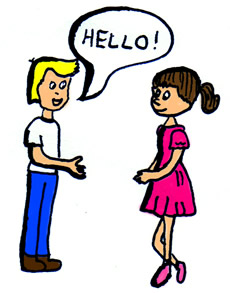
Resources
My husband teases me that I could start up a conversation with a shoe. My son complains that he can't get me to leave any group activities because I am being social. He sees this as a negative.
For some, starting conversations come naturally. For others, starting a conversation can be very challenging. When meeting someone for the first time do you feel shy and uncomfortable? Are you worried that you won’t know what to say?
Social Skills: 4 steps to help your child engage in conversation
 Are You A Social Butterfly?
Are You A Social Butterfly?
My husband teases me that I could start up a conversation with a shoe. My son complains that he can't get me to leave any group activities because I am being social. He sees this as a negative.
For some, starting conversations come naturally. For others, starting a conversation can be very challenging. When meeting someone for the first time do you feel shy and uncomfortable? Are you worried that you won’t know what to say?
How Rude!
For children with social skills deficits, starting a conversation can be a difficult part of daily life. Often they are expected to start a conversation or respond to a greeting. When no words are forthcoming the child is perceived as being rude. Here are four steps you can take to help your child engage in conversation:1. The Approach
One of the most important parts of conversation is eye contact. Work on making eye contact with your child.- When your child is talking encourage them to make eye contact while talking.
- Have your child practice greeting family members while looking them in the eye.
2. Appropriate Greetings
Work on appropriate words for greeting a person. Discuss which greetings are appropriate for whom. For example:- It is fine to say "What's up?" to a friend but it would be disrespectful to do so to your grandmother's friend
- It is ok to ask your friend about the new release of the latest video game, but probably not your teacher.
3. Continuing the Conversation
Conversations, of course, cannot be limited to "Hi". You have to have follow-up dialogue and that requires a topic of interest. I recall many conversations with my grandparents in Australia about the weather. I just didn't know what to talk to them about. It would have been helpful to have a list of topics prepared ahead of time. Using that same idea:- Create a set of cards with topics for conversation.
- Divide the topics based on the person they are appropriate for (conversation ideas for your friends would be in one section, teachers in another and so on).
- Create a visual: For the people your child will interact with most have a picture of them and discuss with your child in advance what you would like to talk to them about.
4. Practice! Practice! Practice!
Take every opportunity to practice! Modelling and practice are critical components.- Enlist the help of family members, friends, teachers and peers to help model and practice greeting and conversing.
- Encourage your child to greet anyone that comes to your house, even the mail carrier can be greeted politely. If you go to a store, have your child greet the clerk behind the counter.



